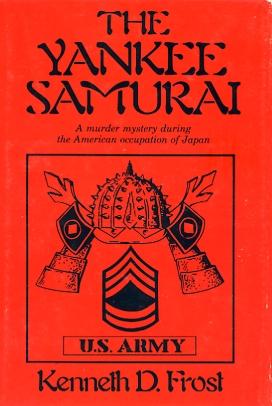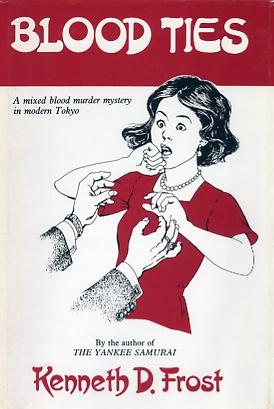Occupational hazards
Retired soldiers never die, they just write away
By William Wetherall
First posted 5 May 2010
Last updated 7 May 2010
Kenneth D. Frost, The Yankee Samurai, 1987
Kenneth D. Frost, Blood Ties, 1988

The Yankee SamuraiKenneth D. Frost After his arrival in Tokyo Bay on a U.S. Army transport, the protagonist, Technical Sergeant O'Brien, receives orders assigning him to the Shogo Prefecture Military Goverenment Team in Anju City -- fictional places about three hours out from Ueno station. During World War II, O'Brien had served in North Africa and Europe. Hearing stories of the jungle fighting in the South Pacific he had felt fortunate, but "after a short period of civilian life (which he found to be stereotypical and boring) he had reenlisted in the army and asked for duty in the Far East" (page 2). O'Brien had expected to be sent to an infantry division in Korea but was informed he was was one of "about 120 senior NCOs with clean records and special talents" who had been singled out out "to add maturity and experience to this vital attempt to reeducate and democratize the Japanese nation" -- pursuant to a request by General MacArthur for such men (page 2). By page 29, O'Brian -- "actually a rather shy, inexperienced man with women" -- was being bathed by a girl with a "slim, honey-brown body" who caused him to feel "a long-suppressed desire burning through him as she took his hand and led him back upstairs to their room" (pages 29-30). Frost's attempts at characterization and drama in this and subsequent sex scenes, and the thin plot he manages to develop between them, left me wondering if the English literature he was teaching was teaching at the University of Tsukuba and Ibaraki University (see "Biographical note" below) was drawn from a collection of Army training manuals. Come to think of it, Tsukuba is in Ibaraki prefecture, the capital of which is Mito. And Mito would be reached on a train out of Ueno taking about as long as it took O'Brien to reach Anju. Jacket promotionsThe simplicity of the jacket design and promotional texts is typical of low-budget Vantage Press publications.
Author's NoteFrost introduces the novel like this (unpaginated).
Why is it that so many people call it "the American occupation of Japan"? |

Blood TiesKenneth D. Frost At 63 spacy large-point pages, this story weighs more like a novella. With "cluttered dresser" and "slim shapely figure" in the first paragraph and "messed-up room" and "narrow waist" and "carelessly thrown over a chair" in the second, it reads more like a finger exercise in redundancy and clunkiness. The 63 pages are split into 15 titled chapters that average barely 4 pages each -- compared to the 148 pages and 16 chapters of The Yankee Samurai. The chapters of Blood Ties might have been longer if Keiko, the protagonist, hadn't been such a good girl. She smokes, though, and toward the end, a young "male chauvinist" detective named Hirano (page 55), who has taken a liking to her, is warning her "It's not good for her health" (page 62). Hirano, informing Keiko that her father's killer had been caught, tells her she should be proud of her father. She "flippantly" agrees that she should be, given their "blood ties" -- at which Hirano directs his eyes downward and says "Keiko San, perhaps we should start our own blood ties" (page 62). "Is that a proposal?" she asks. "Yes," he says. She waits a moment before saying, "Aren't you even going to kiss me?" A minimalist, in half the number of pages, would have ended this mystery-turned-romance here. Frost, though, adds another sentence: "She felt a passionate reaction to their first embrace and kiss that reassured her that [read the book], and she smiled as she reflected on how she would [read the book]" (page 63). Jacket promotionsThe picture on the jacket is presumably of the protagonist Keiko. She is about to be chocked or embraced -- or pushed or stopped from falling backwards -- depending on the beholder's state of mind.
Frost on "half-caste" and "mixed-blood"Frost prefaces this very short novel like this (page vii).
Frost is compiling his own dictionary. The term "half-caste" by no "especially" denotes a person of mixed European and Asian parentage. And "chi no kizuna" (血の絆) means only "ties of blood" and is not, on its own strength, a synonym for "mixed blood". The equivalent of the English term "mixed blood" in Japanese, literally and metaphorically, is "konketsu" (混血). The term easily compounds with other terms to form expressions ranging from "konketsuji" (混血児) or "mixed-blood child" to "konketsuki" (混血機) or "mixed-blood machine" (i.e., an aircraft or other such product of multinational or hybrid design, technology, and manufacture). "Konketsuji" has today been all-but replaced by the equally racialist term "haafu" (ハーフ) meaning "half [alien]". |
Biographical note
The back flaps of the jackets of both books describe the author like this.
About the authorKenneth D. Frost was born in Berlin, New Hampshire. He was educated in New York and Ohio and attended the University of Michigan and Ohio University, graduating from the latter in 1940. After his graduation until the beginning of World War II he was a junior executive learning the paper manufacturing business in Alton, Illinois. He served in the European theater of operations during World War II and later in the Korean conflict. He retired as an army officer in 1963 after twenty-one years of service. Since retiring from service he has lived in Japan, teaching English literature at the University of Tsukuba and Ibaraki University. For his contributions to Japanese cultural activities he was presented with the Order of the Sacred Treasure, fourth class, by the Emperor in 1984. |